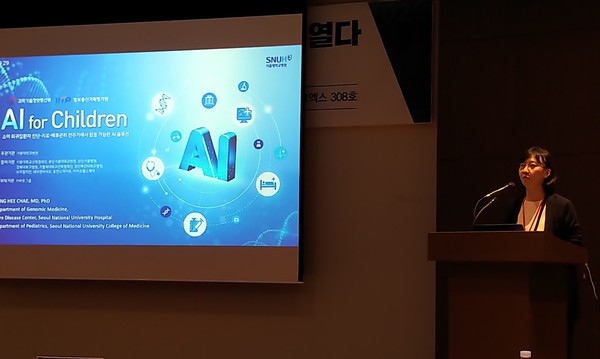Artificial intelligence (AI) integrated solutions that can be used through the entire cycle of diagnosing, treating, and managing prognosis for children with rare diseases will be developed.
With the infrastructure for treating rare diseases concentrated in the Seoul metro region, provincial children with rare diseases have missed the time for the early diagnosis and treatment of their diseases. However, if the solution is developed, it will become possible to diagnose and treat those children at an early phase, according to experts.
Professor Chae Jong-hee of the Department of Pediatrics and Adolescents at Seoul National University Hospital (SNUH) made these and other points while presenting “AI integrated solution for multifaceted analysis of rare childhood diseases” at a seminar organized by the National IT Industry Promotion Agency as part of the K-HOSPITAL FAIR 2022-KHF 2022 at COEX in southern Seoul on Thursday.

More than 7,000 rare childhood diseases have low incidence and prevalence, making it difficult to diagnose and provide proper treatment.
In particular, the number of doctors who specialize in rare childhood diseases is small, and treatment infrastructure is concentrated in Seoul and its vicinity, taking up to six years to diagnose them.
The problems do not end there. As there is no "disease name" during the time taken to be diagnosed as a rare disease, it is difficult for patients to receive financial support for diagnosis and treatment.
“More than 50 percent of doctors who see rare childhood diseases are in the greater Seoul area, and the high-level technology needed for diagnosis is also concentrated in the metro region, leaving most patients no choice but to flock to Seoul and its vicinity,” Professor Chae said.
The current situation is that medical expenses or treatment expenses are not supported because the diagnosis name is not attached for a long time taken to diagnose the disease. In addition to symptoms and pains for patients, the financial and social burdens on their families are also very big, he added.
All of these made 11 large domestic hospitals begin to develop “AI for Children (A4C)” jointly, which can reduce the imbalance in patient referral and return between the greater Seoul area and provinces due to the gap in diagnostic ability and treatment levels of rare diseases, and present improvement directions for diagnosis, treatment, and prognosis management of rare diseases in children. ,
A4C is an AI solution, which creates large-scale data through a network connection between the metro region and the regional centers, builds an accurate diagnostic algorithm based on this, and provides customized treatment information for about 7,000 rare diseases, and enables prognosis management.
The diseases subject to the solution were divided into nine areas -- rare genetic metabolic diseases, congenital multiple deformities, cerebral nerve diseases, hereditary heart disease, hereditary kidney disease, inflammatory growth disease, congenital immunodeficiency disease, childhood blood tumor disease, and hereditary myopathy disease
hospitals, including SNUH, and businesses participate in developing the technology, investing 8 billion won ($5.6 million) to develop the integrated AI solution over the next three years. Professor Chae takes overall responsibility for the project.
“If we collect high-quality data collected in tertiary hospitals and turn them into massive big data, and diagnose patients using software based on the genome, it will keep patients from concentrating in the Seoul metro region by helping them receive diagnose at major regional hospitals,” Chae said.
The pediatric specialist explained that there is a rare disease prototype specialized in prognosis management monitoring.
“For example, in the case of congenital metabolic disease, if patients manage their diet and exercise well and monitor well, they can avoid emergencies. If doctors plant a solution in their patients' mobile and check this information, patients don't have to go to the emergency room frequently due to anxiety."
Professor Chae stressed that the A4C development is aimed to reduce disability through early diagnosis and treatment of rare diseases, and, furthermore, to help children play a social role.
“It is a great loss to find rare diseases late and make children have disabilities," he said. “We should make a child born healthy healthier. However, even if children have some disabilities, if their parents detect them early and treat them early, these children will be able to play a social role as healthy people by reducing disabilities."
Professor Chae added that it's also the goal of the project to help families and parents get out of their misery.

